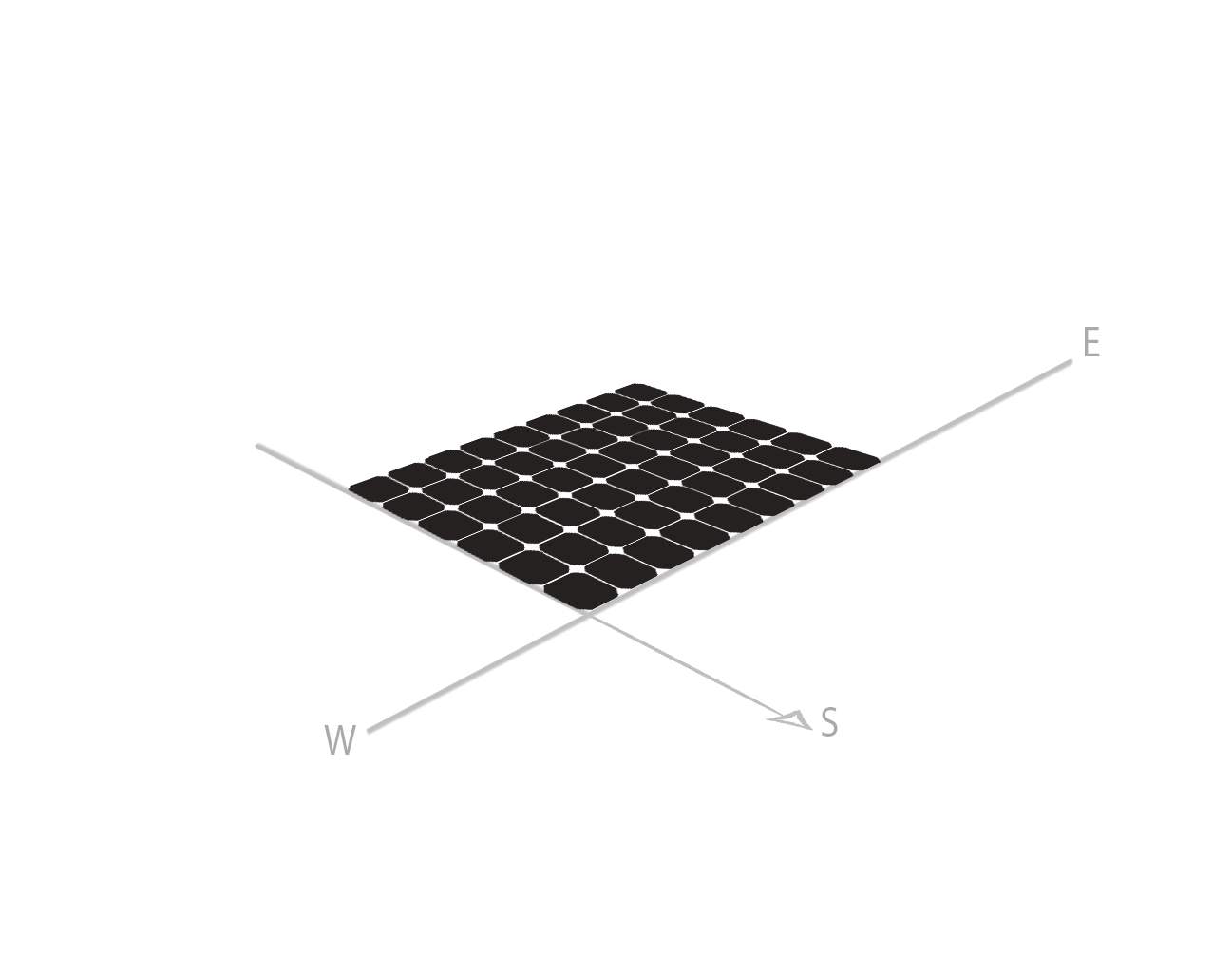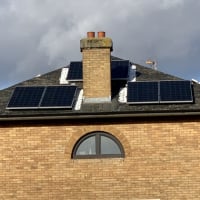We’d like to remind Forumites to please avoid political debate on the Forum.
This is to keep it a safe and useful space for MoneySaving discussions. Threads that are – or become – political in nature may be removed in line with the Forum’s rules. Thank you for your understanding.
Roof and Panel advice needed.
Comments
-
This is a better link - takes you straight to the calculator
JRC Photovoltaic Geographical Information System (PVGIS) - European Commission (europa.eu)
0 -
I too would be interested in an elaboration of that comment relative to seeing an estimate of power produced per annum vs installation cost.
In my original post I referred to getting more output in winter. A northish facing roof won't generate more, in total, over a year, but it will generate more when it is is most needed/export prices are most favourable. Similarly, a steeper roof pitch will have benefits in winter and at each end of the day. A south facing roof just produces far more than you need at the time you don't want it (unless you have air-conditioning).
The above needs to be thought about in conjunction with battery storage and what prices can be obtained on export tariffs, especially TOU export.
Solar isn't as simple as it used to be in the FiT days.
0 -
Thanks Nick.Nick_Dr1 said:This is a better link - takes you straight to the calculator
JRC Photovoltaic Geographical Information System (PVGIS) - European Commission (europa.eu)
I think I may need help using/understanding it though.
I have put in my Lat/Lon, installed peak, slope, and azimuth, and left the rest alone.
But, unless I have messed up the azimuth (likely), I see barely any difference between the more north, and more south facing roofs, for a given peak installed power. Am I reading it wrong?
From my diagram in the OP, would I be correct to use an azimuth of 135 for the north'ish roof, an -45 for the opposite?
With kWp of 6.4, It says 638kWh for June @ 135, and 770kWh for June @ -45. I expected more of a difference on opposing roofs.0 -
I think I am getting something wrong in PVGIS, because it is showing (for equivalent kWp) that the north'ish roof would be very poor in winter months.Netexporter said:I too would be interested in an elaboration of that comment relative to seeing an estimate of power produced per annum vs installation cost.In my original post I referred to getting more output in winter. A northish facing roof won't generate more, in total, over a year, but it will generate more when it is is most needed/export prices are most favourable. Similarly, a steeper roof pitch will have benefits in winter and at each end of the day. A south facing roof just produces far more than you need at the time you don't want it (unless you have air-conditioning).
The above needs to be thought about in conjunction with battery storage and what prices can be obtained on export tariffs, especially TOU export.
Solar isn't as simple as it used to be in the FiT days.
0 -
lstar337 said:
Thanks Nick.Nick_Dr1 said:This is a better link - takes you straight to the calculator
JRC Photovoltaic Geographical Information System (PVGIS) - European Commission (europa.eu)
I think I may need help using/understanding it though.
I have put in my Lat/Lon, installed peak, slope, and azimuth, and left the rest alone.
But, unless I have messed up the azimuth (likely), I see barely any difference between the more north, and more south facing roofs, for a given peak installed power. Am I reading it wrong?
From my diagram in the OP, would I be correct to use an azimuth of 135 for the north'ish roof, an -45 for the opposite?
With kWp of 6.4, It says 638kWh for June @ 135, and 770kWh for June @ -45. I expected more of a difference on opposing roofs.PVGIS definition of azimuth, or orientation, is the angle of the PV modules relative to the direction due South. -90° is East, 0° is South and 90° is West. Think you have that right.
What did you put as slope? Pvgis is not clear has this gif suggesting it's relative to E-W. Try a negative number for the North facing roof 6.75kwp (15 * 450W) SSE facing
6.75kwp (15 * 450W) SSE facing
5KW Solaredge Homehub
9.7KWh Solaredge Battery
Sunny(ish) Berkshire0 -
I put the slope as 40°, as I assume it meant the slope of the roof?charles_b_2 said:lstar337 said:
Thanks Nick.Nick_Dr1 said:This is a better link - takes you straight to the calculator
JRC Photovoltaic Geographical Information System (PVGIS) - European Commission (europa.eu)
I think I may need help using/understanding it though.
I have put in my Lat/Lon, installed peak, slope, and azimuth, and left the rest alone.
But, unless I have messed up the azimuth (likely), I see barely any difference between the more north, and more south facing roofs, for a given peak installed power. Am I reading it wrong?
From my diagram in the OP, would I be correct to use an azimuth of 135 for the north'ish roof, an -45 for the opposite?
With kWp of 6.4, It says 638kWh for June @ 135, and 770kWh for June @ -45. I expected more of a difference on opposing roofs.PVGIS definition of azimuth, or orientation, is the angle of the PV modules relative to the direction due South. -90° is East, 0° is South and 90° is West. Think you have that right.
What did you put as slope? Pvgis is not clear has this gif suggesting it's relative to E-W. Try a negative number for the North facing roof.
0 -
That's correct.lstar337 said:
I put the slope as 40°, as I assume it meant the slope of the roof?charles_b_2 said:lstar337 said:
Thanks Nick.Nick_Dr1 said:This is a better link - takes you straight to the calculator
JRC Photovoltaic Geographical Information System (PVGIS) - European Commission (europa.eu)
I think I may need help using/understanding it though.
I have put in my Lat/Lon, installed peak, slope, and azimuth, and left the rest alone.
But, unless I have messed up the azimuth (likely), I see barely any difference between the more north, and more south facing roofs, for a given peak installed power. Am I reading it wrong?
From my diagram in the OP, would I be correct to use an azimuth of 135 for the north'ish roof, an -45 for the opposite?
With kWp of 6.4, It says 638kWh for June @ 135, and 770kWh for June @ -45. I expected more of a difference on opposing roofs.PVGIS definition of azimuth, or orientation, is the angle of the PV modules relative to the direction due South. -90° is East, 0° is South and 90° is West. Think you have that right.
What did you put as slope? Pvgis is not clear has this gif suggesting it's relative to E-W. Try a negative number for the North facing roof.0 -
Netexporter said:I too would be interested in an elaboration of that comment relative to seeing an estimate of power produced per annum vs installation cost.
In my original post I referred to getting more output in winter. A northish facing roof won't generate more, in total, over a year, but it will generate more when it is is most needed/export prices are most favourable. Similarly, a steeper roof pitch will have benefits in winter and at each end of the day. A south facing roof just produces far more than you need at the time you don't want it (unless you have air-conditioning).
The above needs to be thought about in conjunction with battery storage and what prices can be obtained on export tariffs, especially TOU export.
Solar isn't as simple as it used to be in the FiT days.
Good thinking regarding trying to get more output in winter when it is most needed and at times when export prices are favourable. I had not been thinking along the lines of export income!It is still poor output from a Northish facing panel a) in winter and b) towards the end of a winter's day is it not?I know my roof gets sod all pv generation owing to lack of sunlight ( very low in the sky ) by 4 p.m. in the depths of winter for a South facing panel and the North facing roof is shaded behind the ridge.Istar will be able to estimate if it is worthwhile at his location/ orientation using PVGIS1 -
I think thats right? Very low sun in the winter (and only available for short periods) and the roof is facing the wrong way!lstar337 said:
I think I am getting something wrong in PVGIS, because it is showing (for equivalent kWp) that the north'ish roof would be very poor in winter months.Netexporter said:I too would be interested in an elaboration of that comment relative to seeing an estimate of power produced per annum vs installation cost.In my original post I referred to getting more output in winter. A northish facing roof won't generate more, in total, over a year, but it will generate more when it is is most needed/export prices are most favourable. Similarly, a steeper roof pitch will have benefits in winter and at each end of the day. A south facing roof just produces far more than you need at the time you don't want it (unless you have air-conditioning).
The above needs to be thought about in conjunction with battery storage and what prices can be obtained on export tariffs, especially TOU export.
Solar isn't as simple as it used to be in the FiT days.
3 -
And in the opposite incline! North facing rooftop panels installed at >20 degrees actually underperform heavily shaded South facing panels. There is no way to say this other than to describe it as entirely suboptimal - you will see 30-40% the performance of a South facing panel on the same roof, if that.Nick_Dr1 said:I think thats right? Very low sun in the winter (and only available for short periods) and the roof is facing the wrong way!- 10 x 400w LG Bifacial + 6 x 550W SHARP BiFacial + 2 x 570W SHARP Bifacial + 5kW SolarEdge Inverter + SolarEdge Optimizers. SE London.
- Triple aspect. (33% ENE.33% SSE. 34% WSW)
- Viessmann 200-W on Advanced Weather Comp. (The most efficient gas boiler sold)Feel free to DM me for help with any form of energy saving! Happy to help!1
Confirm your email address to Create Threads and Reply

Categories
- All Categories
- 352.3K Banking & Borrowing
- 253.7K Reduce Debt & Boost Income
- 454.4K Spending & Discounts
- 245.4K Work, Benefits & Business
- 601.1K Mortgages, Homes & Bills
- 177.6K Life & Family
- 259.2K Travel & Transport
- 1.5M Hobbies & Leisure
- 16K Discuss & Feedback
- 37.7K Read-Only Boards




